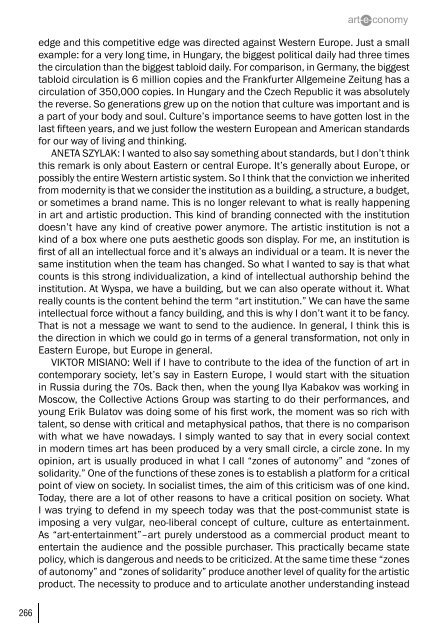art-e-conomy _ reader - marko stamenkovic
art-e-conomy _ reader - marko stamenkovic
art-e-conomy _ reader - marko stamenkovic
You also want an ePaper? Increase the reach of your titles
YUMPU automatically turns print PDFs into web optimized ePapers that Google loves.
266<br />
edge and this competitive edge was directed against Western Europe. Just a small<br />
example: for a very long time, in Hungary, the biggest political daily had three times<br />
the circulation than the biggest tabloid daily. For comparison, in Germany, the biggest<br />
tabloid circulation is 6 million copies and the Frankfurter Allgemeine Zeitung has a<br />
circulation of 350,000 copies. In Hungary and the Czech Republic it was absolutely<br />
the reverse. So generations grew up on the notion that culture was important and is<br />
a p<strong>art</strong> of your body and soul. Culture’s importance seems to have gotten lost in the<br />
last fifteen years, and we just follow the western European and American standards<br />
for our way of living and thinking.<br />
ANETA SZYLAK: I wanted to also say something about standards, but I don’t think<br />
this remark is only about Eastern or central Europe. It’s generally about Europe, or<br />
possibly the entire Western <strong>art</strong>istic system. So I think that the conviction we inherited<br />
from modernity is that we consider the institution as a building, a structure, a budget,<br />
or sometimes a brand name. This is no longer relevant to what is really happening<br />
in <strong>art</strong> and <strong>art</strong>istic production. This kind of branding connected with the institution<br />
doesn’t have any kind of creative power anymore. The <strong>art</strong>istic institution is not a<br />
kind of a box where one puts aesthetic goods son display. For me, an institution is<br />
first of all an intellectual force and it’s always an individual or a team. It is never the<br />
same institution when the team has changed. So what I wanted to say is that what<br />
counts is this strong individualization, a kind of intellectual authorship behind the<br />
institution. At Wyspa, we have a building, but we can also operate without it. What<br />
really counts is the content behind the term “<strong>art</strong> institution.” We can have the same<br />
intellectual force without a fancy building, and this is why I don’t want it to be fancy.<br />
That is not a message we want to send to the audience. In general, I think this is<br />
the direction in which we could go in terms of a general transformation, not only in<br />
Eastern Europe, but Europe in general.<br />
VIKTOR MISIANO: Well if I have to contribute to the idea of the function of <strong>art</strong> in<br />
contemporary society, let’s say in Eastern Europe, I would st<strong>art</strong> with the situation<br />
in Russia during the 70s. Back then, when the young Ilya Kabakov was working in<br />
Moscow, the Collective Actions Group was st<strong>art</strong>ing to do their performances, and<br />
young Erik Bulatov was doing some of his first work, the moment was so rich with<br />
talent, so dense with critical and metaphysical pathos, that there is no comparison<br />
with what we have nowadays. I simply wanted to say that in every social context<br />
in modern times <strong>art</strong> has been produced by a very small circle, a circle zone. In my<br />
opinion, <strong>art</strong> is usually produced in what I call “zones of autonomy” and “zones of<br />
solidarity.” One of the functions of these zones is to establish a platform for a critical<br />
point of view on society. In socialist times, the aim of this criticism was of one kind.<br />
Today, there are a lot of other reasons to have a critical position on society. What<br />
I was trying to defend in my speech today was that the post-communist state is<br />
imposing a very vulgar, neo-liberal concept of culture, culture as entertainment.<br />
As “<strong>art</strong>-entertainment”–<strong>art</strong> purely understood as a commercial product meant to<br />
entertain the audience and the possible purchaser. This practically became state<br />
policy, which is dangerous and needs to be criticized. At the same time these “zones<br />
of autonomy” and “zones of solidarity” produce another level of quality for the <strong>art</strong>istic<br />
product. The necessity to produce and to <strong>art</strong>iculate another understanding instead


